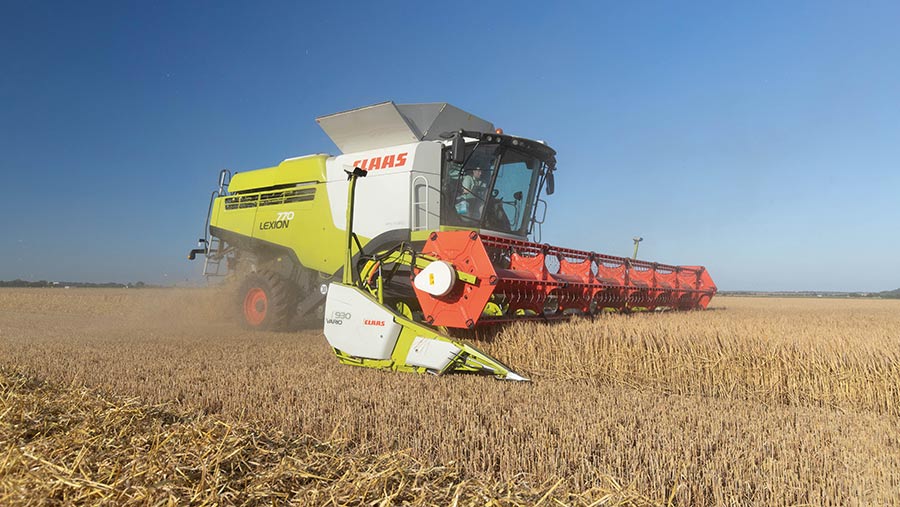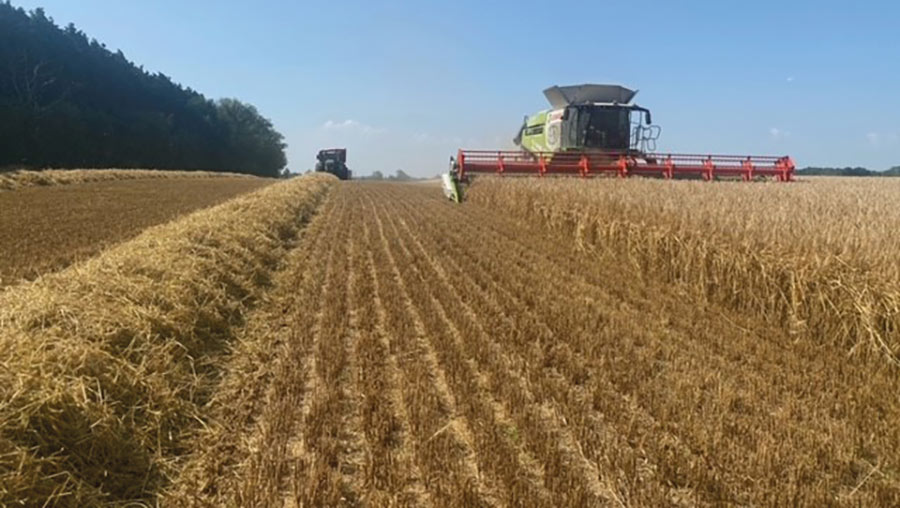Winter barley harvest kicks off two weeks later than usual
 © Tim Scrivener
© Tim Scrivener Harvest 2021 is finally under way as combines roll into fields of winter barley and growers make the most of the warm, dry weather, with harvest starting about two weeks later than usual.
As temperatures reach highs of 30C, initial yields and quality look good, despite the rocky start to the season with yet another wet, soggy winter, a cold, dry April, and May monsoons restricting crop growth.
See also: First winter barley cut in Merseyside to grab market premium
Lincolnshire
Lincolnshire grower Mark Ireland started harvest last Thursday at Rauceby Grange Farm near Sleaford, where he cut 120ha of winter barley and is pleased with results so far, with higher grain and straw yields than last year.
“We made a start on the variety Flagon and yield and quality is looking good,” he says. “Given the fact that crops were stressed in April and we lost a few tillers, it has been a better start to harvest than we originally expected.
“It is still early days, but crops are doing well, with yields looking better than our budgeted five-year average of 6.8t/ha.”
Grain is coming in about 15% moisture and getting down to 12.5% during the day.
“So far, harvest has been a rather stop-start process. Despite such warm weather, we haven’t been cutting until midday as the mornings have been particularly damp.
Specific weights are down a bit on average at about 63-64kg/hl, with low grain nitrogen.
The varieties Flagon, Electrum and Craft are being grown this season on a range of different malting contracts.
Last weekend, Mr Ireland made a start on the variety Craft, but results didn’t seem as fruitful compared with the crop of Flagon. But with plenty more left to cut, there is still time for this to change.
“Crops of barley missed out on a lot of sun this season, so we’re hoping that the warm weather will really push on our wheat crops,” he adds.
All winter barley straw will be baled for use as animal feed and bedding, before planting a black oat and vetch cover crop ahead of either spring barley or sugar beet.
Another 100ha of winter barley is yet to be cut before oilseed rape and spring barley harvest commences.
Wiltshire
Further south in Wiltshire, mixed farmer David Butler made a start on his feed winter barley varieties Gimlet and Kingsbarn and is delighted to be harvesting in such good summer weather conditions.
“We’re happy with how things are going so far,” he says. “Yields are down by 20% on last year at approximately 7t/ha, but this is nothing alarming as winter barley was our highest performing crop last year.”
Temperatures above 30C have resulted in very low grain moisture levels of 12-13%, with borderline specific weights, with some crops therefore requiring a quick clean before storage.
Grain temperatures have reached as high as 35C, resulting in more problems associated with the cooling rather than drying of the grain – something UK farmers perhaps aren’t that used to.
In fact, Mr Butler reports that one of the combine’s components overheated in such high temperatures which forced him to stop cutting for a couple of hours to let the combine cooled down.
He reminds farmers of the potential fire risks associated with harvesting in warm weather and the need for an all-important fire plan in the unfortunate event that one breaks out.
Next on the harvest to-do list will be 180ha of oilseed rape, which has been desiccated and therefore will be ready to cut in two weeks’ time.
Cambridgeshire
For James Peck of PX Farms based in Cambridgeshire, winter barley harvest usually starts during the first couple days in July, but this year’s slow growing season meant he began cutting a good two weeks later than usual on July 16.
After a challenging season struggling to get cereals crops drilled into such wet autumn conditions, combined with the physical strains of lockdown, Mr Peck is relieved to see harvest now under way.
With 485ha of winter barley in the ground, crops are yielding well at 8.8t/ha, with moisture contents below 15% and a slightly lower specific weight of 61-62kg/hl.

© James Peck
Currently, four combines are in operation and rather than using a traditional tractor and trailer, Mr Peck uses chaser bins and loading lorries equipped with 30t custom-built trailers to transport grain. This helps improve efficiency of loading times and ensures the combines are not waiting to unload.
The variety Belfry makes up the majority of Mr Peck’s winter barley area this season, due to its good lodging resistance. After a significant area of the variety Bazooka fell flat last harvest, only a small proportion of this was planted, with the remainder planted to Belfry.
All straw will be baled, and has been pre-sold to either a local power station or beef farm, while grain is sold to ADM.
“Next, we will have 20ha of oilseed rape to harvest, and we are planning to put more area to this next season, if conditions allow. Meanwhile, winter wheat crops are still looking as green as grass, so it will be a little while yet before we think about harvesting them.”

